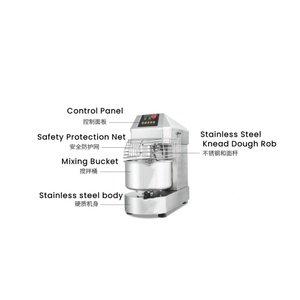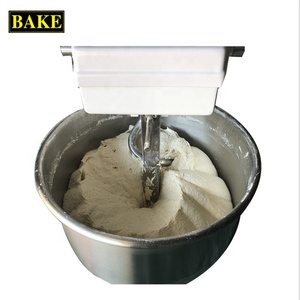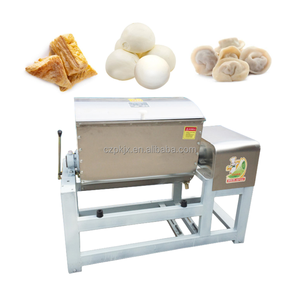(1667 products available)









































































































































































































30-kg dough mixers are often classified according to how the mixing mechanism works, the energy source, and the use. Commercial businesses must consider their production demands before selecting a type. The following are typical 30-kg dough mixers.
This type is mostly used in commercial bakeries because it mixes the dough well and thus enables large production capacity. The spiral attachments help homogenize the ingredients, develop gluten, and make thicker quantities smoother than other mixers. This adheres to the requirement for consistent, high-quality dough in commercial entities.
High-velocity dough mixers are intended for large volumes of production where quick mixing is often required. In an industrial context, where time savings cause efficiency increase, this type of mixer is applicable. However, the high-speed version is better suited for mixing softer doughs, such as those for pastries or pizza bases, rather than doughs for bread.
These mixers are ideal for smaller-scale commercial operations, such as pastry shops or smaller bakeries. They are named after the "planetary" mixing arms, which rotate around the bowl in an orbital motion, mixing the dough well. Although they normally have smaller capacities than spiral or high-speed mixers, 30-kg planetary mixers are suitable for businesses that need versatility and consistency.
Compared to other mixers, vertical mixers have a different construction, where the mixing elements are positioned vertically. The way it is made allows for homogeneous mixing, which is important for such mixtures where all ingredients must be thoroughly combined. Vertical mixers are applicable for high-density products, including heavy bread dough, due to their strong mixing mechanism.
A 30-kg dough mixer should, therefore, have a powerful motor for mixing large amounts of dough, and various speed settings are useful for different mixing operations. Low speed is helpful for mixing ingredients when mixing is not so vigorous, such as kneading dough, which is required for developing gluten. In contrast, high speeds are useful for mixing in small quantities of ingredients, such as water or fats, to avoid clumping.
This feature makes working very convenient for users because it does not require any hand lifting of the bowl during the process. Hence, the lift bowl feature provides a great advantage, especially for those organizations that process huge batches of ingredients since manual lifting can be very tasking. That feature may also be hydraulic or electrical, but either way, the focus is on the convenience and safety of the mixing process.
Commercial equipment must withstand constant use. As such, 30-kg dough mixers are commonly constructed from metal parts like steel or stainless steel to ensure longevity and maintain their strength. Depending on the use, a durable mixer will also be resistant to corrosion and wear, meaning the mixer can be used for a long time without replacing it.
One will not be able to run the machine unless the covers are properly placed. These features help reduce industrial accidents, thus increasing safety in the workplace. Also, some models incorporate automatic shut-off functions when the mix is finished or when the device is overloaded, which helps prevent damage and boosts safety as well.
If there are extra attachments on the mixer, it can serve other purposes and not just be tailored to kneading. For instance, a whisk attachment can make dough preparations for pastry and heavy mixtures with a kneading hook. These attachments increase the usage of the mixer in different recipes, thus saving space in the kitchen.
A 30-kg dough mixer is widely used in industries. Large commercial bakeries and food factories benefit from using this kind of mixer because it increases efficiency and guarantees quality, and it is suitable for large quantities of dough that are beyond the capabilities of small mixers. Here are practical applications of these.
Bakeries require large quantities of dough for bread, rolls, pastries, and more. A 30-kg dough mixer makes the blending and kneading of this dough easy. This ensures tasty and high-quality bread. When it comes to mass production, the consistency of the mixer means that every batch will be the same with regard to quality and texture, which is crucial to the bakery in satisfying its customers as well as meeting its own standards.
When making pizza on a large scale, a 30-kg dough mixer will be necessary for uniformity and efficiency. The pizza crust is a huge component of any pizza and must be manufactured with consistency. A bit of variation in the crust can affect the taste and texture, leading to customer complaints. A large-scale pizza maker will find a vigorous mixer that helps produce the same quality crust every time.
Dough is a common ingredient in many other food products, such as pies, pastries, and dumplings. Such mixers are used in factories to produce prepackaged baked goods sold in grocery stores, thereby saving time and quality. Given that these factories are high-volume operations, the requirement for an efficient mixer and also one that guarantees consistency is crucial.
A 30-kg dough mixer can be useful for companies that make pretzels or breadsticks by ensuring uniform and consistent mixing of their dough. As with any other baked product, the consistency of the dough affects the final product in terms taste and texture. Companies that manufacture breadsticks or pretzels would invest in a high-quality mixer to help maintain quality.
It can be a challenging task, especially with some of the important factors that one must consider. These factors include the type of dough that is commonly processed, the volume of the desired output, the available space, and the budget. Considering the following points helps in choosing appropriately.
Different 30-kg mixers work well with different types of dough. Spiral mixers are best suited for heavy bread dough, while planetary and high-speed mixers are better suited for lighter pastry dough. The primary purpose of the mixer determines the type that should be selected. For organizations making pizza or pastries, a planetary or high-speed mixer will suffice, while a spiral mixer is more appropriate for bread and other dense dough.
This is also termed the duty cycle of the machine. If the machine is to be used on a daily basis and for long hours, one needs to get a robust one with a powerful motor; it should have speed variations too. If the usage is to be light and occasional, a lower-powered dough mixer can serve the purpose just as effectively, though one should be careful that the usage is not more than recommended.
It is advisable to select mixers with easy maintenance features. Machines with removable, easy-to-clean parts are easier to maintain. Also, consider the support available for the machine, including warranties and the availability of spare parts. Some manufacturers offer better support and more durable equipment, which is significant in its long-term utilization.
Commercial mixers are a sizeable investment, though one thinks of the returns it brings. Additionally, when creating a budget, one needs to consider the cost of maintenance, energy usage, and the operational costs of the model chosen. If the mixer is of good quality, it does not need to be replaced frequently; this will save in the long run.
Generally, 30-kg mixers are used in baking, pizza production, and other food manufacturing industries where large continuous flows of uniform dough are required.
Yes, specific types of 30-kg dough mixers are appropriate for thick and dense types of dough. For instance, spiral mixers are designed for heavy dough, which means they can handle high-gluten mixtures like bread dough, while planetary and high-speed mixers are appropriate for lighter doughs.
The difference lies in the fact that it produces better results for thick doughs generally used for bread by means of its special spiral mixing system. This mixer knows how to combine and knead the ingredients without excessive heat and for a longer time. This develops the desired gluten structure.
For proper maintenance, the key is regular cleaning after every use, checking for worn-out parts, and ensuring adequate lubrication, which in turn extends the life of the mixer.
Bowl lift makes the mixing process convenient, especially in high-volume commercial settings since it eliminates the need to lift the bowl manually.